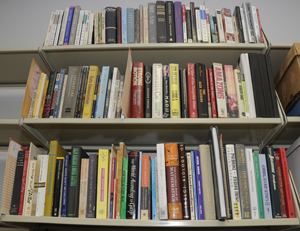 A literary archive should not be viewed as a full and unadulterated view into the mind of the author. The act of assembling the archive, choosing what exactly is put into the archive, creates only a fractured, often stage-directed, image of authors and their work. A good example of this is the David Foster Wallace archive, assembled by Karen Green and Bonnie Nadell (his widow and agent respectively). The archive, as bought by the Harry Ransom Center, is carefully presented: there is little personal correspondence, no journals or other documents relating to Wallace’s intimate and private life. The archive concentrates on the work: typescripts, notebooks, rough drafts, the occasional scribbling of nascent ideas. Similarly, only items from Wallace’s library that he annotated were put into the archive, meaning only a slight fragment of Wallace’s literary life can be determined. Continue reading
A literary archive should not be viewed as a full and unadulterated view into the mind of the author. The act of assembling the archive, choosing what exactly is put into the archive, creates only a fractured, often stage-directed, image of authors and their work. A good example of this is the David Foster Wallace archive, assembled by Karen Green and Bonnie Nadell (his widow and agent respectively). The archive, as bought by the Harry Ransom Center, is carefully presented: there is little personal correspondence, no journals or other documents relating to Wallace’s intimate and private life. The archive concentrates on the work: typescripts, notebooks, rough drafts, the occasional scribbling of nascent ideas. Similarly, only items from Wallace’s library that he annotated were put into the archive, meaning only a slight fragment of Wallace’s literary life can be determined. Continue reading
David Foster Wallace
The Meaningful Magic of Manuscripts
 In his 1979 lecture to the Manuscripts Group of the Standing Conference of National and University Libraries (SCONUL), Philip Larkin described the two types of value of a literary manuscript: ‘the magical value and the meaningful value. The magical value is the older, more universal: this is the paper he wrote on, these are the words as he wrote them […] The meaningful value is of much more recent origin, and is the degree to which a manuscript helps to enlarge our knowledge and understanding of a writer’s work’. Manuscripts gain these values from myriad sources, from their textual content to their physical, tactile nature and even their journey through history. Continue reading
In his 1979 lecture to the Manuscripts Group of the Standing Conference of National and University Libraries (SCONUL), Philip Larkin described the two types of value of a literary manuscript: ‘the magical value and the meaningful value. The magical value is the older, more universal: this is the paper he wrote on, these are the words as he wrote them […] The meaningful value is of much more recent origin, and is the degree to which a manuscript helps to enlarge our knowledge and understanding of a writer’s work’. Manuscripts gain these values from myriad sources, from their textual content to their physical, tactile nature and even their journey through history. Continue reading